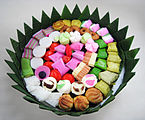Etymology
Translated into English, the word kembang goyang means a shaking flower (kembang). Kue kembang goyang is made of rice flour which is mixed with eggs, sugar, a pinch of salt, coconut milk, and sometimes also food coloring. The mixture will be fried after heating the oil using the kembang goyang mold. After the oil and kembang goyang mold are hot, the mold is then put into the dough and then put into the hot oil again with some slight shakes until the dough is unattached. [4]
This page is based on this
Wikipedia article Text is available under the
CC BY-SA 4.0 license; additional terms may apply.
Images, videos and audio are available under their respective licenses.

